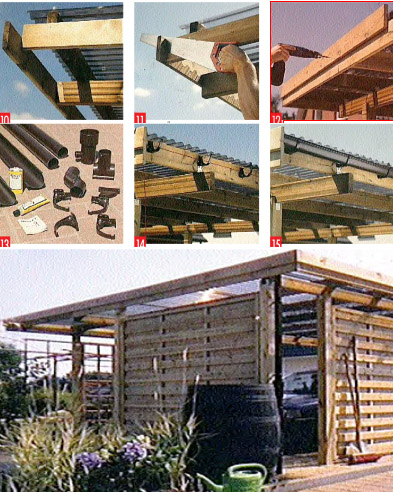 In general it is not necessary, equip a carport of this size with a rain gutter. But there can be two good reasons, to do it. First, a rain gutter prevents, that an untamed torrent of water, for example, falls on the sensitive plants of an adjacent bed. Then the flowers make a rather kinked impression. Second speaks for the rain gutter, that it makes the precipitation usable as irrigation water. It is well known that rainwater is particularly good for plants, of the cost saved for that (expensive!) Not to mention tap water.
In general it is not necessary, equip a carport of this size with a rain gutter. But there can be two good reasons, to do it. First, a rain gutter prevents, that an untamed torrent of water, for example, falls on the sensitive plants of an adjacent bed. Then the flowers make a rather kinked impression. Second speaks for the rain gutter, that it makes the precipitation usable as irrigation water. It is well known that rainwater is particularly good for plants, of the cost saved for that (expensive!) Not to mention tap water.
Therefore it is recommended, the downpipe – see box – fitted with a rain collector, which drains the water into a barrel. Another possibility is this, Install a water drain flap on the downpipe. It acts as a spout. Depending on its position, it diverts the rainwater into a container or lets it fall freely. The "duplex" gutter used here (Marley) takes up as little space as one with an arched profile, but has a larger capacity due to its oval cross-section.
The panels are divided into two, start with the bottom one: It is placed on the head wood of the riders or riders. Saddle beam screwed.
The overhangs of the fascia boards are not delivered to measure and are therefore sawn off directly on the adjoining fascia.
on the lower one, panel that is already installed – shifted upwards - a second screwed on each time, with stainless screws.
The material for installing the gutter at a glance: Gutter moldings and holders, special glue, fittings, cleanser.
The gutter brackets are at a distance of 50 cm screwed onto the beam and form a gradient of approx. 2,5 mm per gutter meter.
The gutter parts are glued together, then latched into the grooves of the holders. Mount the downpipe socket and end pieces beforehand.
The rain gutter is behind the panel on the two saddle beams. Another eye-catcher: the barrel.
A rain collector with an overflow stop is installed in the downpipe. This device is used for that, to divert the water to the sewage system, as soon as the rain barrel is full.